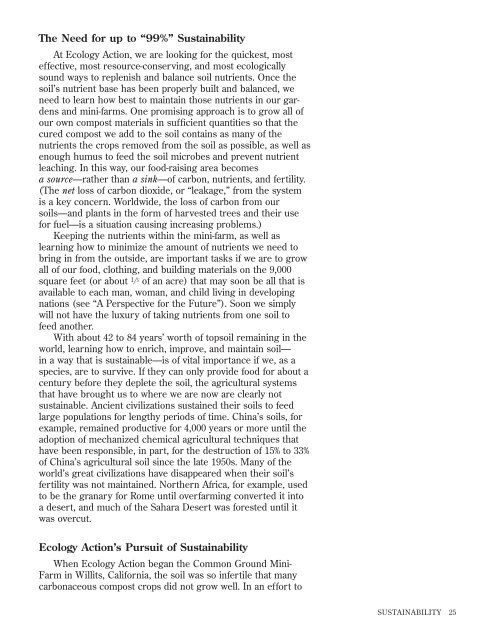How to Grow More Vegetables : And Fruits, Nuts ... - Shroomery
How to Grow More Vegetables : And Fruits, Nuts ... - Shroomery
How to Grow More Vegetables : And Fruits, Nuts ... - Shroomery
You also want an ePaper? Increase the reach of your titles
YUMPU automatically turns print PDFs into web optimized ePapers that Google loves.
The Need for up <strong>to</strong> “99%” Sustainability<br />
At Ecology Action, we are looking for the quickest, most<br />
effective, most resource-conserving, and most ecologically<br />
sound ways <strong>to</strong> replenish and balance soil nutrients. Once the<br />
soil’s nutrient base has been properly built and balanced, we<br />
need <strong>to</strong> learn how best <strong>to</strong> maintain those nutrients in our gardens<br />
and mini-farms. One promising approach is <strong>to</strong> grow all of<br />
our own compost materials in sufficient quantities so that the<br />
cured compost we add <strong>to</strong> the soil contains as many of the<br />
nutrients the crops removed from the soil as possible, as well as<br />
enough humus <strong>to</strong> feed the soil microbes and prevent nutrient<br />
leaching. In this way, our food-raising area becomes<br />
a source—rather than a sink—of carbon, nutrients, and fertility.<br />
(The net loss of carbon dioxide, or “leakage,” from the system<br />
is a key concern. Worldwide, the loss of carbon from our<br />
soils—and plants in the form of harvested trees and their use<br />
for fuel—is a situation causing increasing problems.)<br />
Keeping the nutrients within the mini-farm, as well as<br />
learning how <strong>to</strong> minimize the amount of nutrients we need <strong>to</strong><br />
bring in from the outside, are important tasks if we are <strong>to</strong> grow<br />
all of our food, clothing, and building materials on the 9,000<br />
square feet (or about 1 ⁄ 5 of an acre) that may soon be all that is<br />
available <strong>to</strong> each man, woman, and child living in developing<br />
nations (see “A Perspective for the Future”). Soon we simply<br />
will not have the luxury of taking nutrients from one soil <strong>to</strong><br />
feed another.<br />
With about 42 <strong>to</strong> 84 years’ worth of <strong>to</strong>psoil remaining in the<br />
world, learning how <strong>to</strong> enrich, improve, and maintain soil—<br />
in a way that is sustainable—is of vital importance if we, as a<br />
species, are <strong>to</strong> survive. If they can only provide food for about a<br />
century before they deplete the soil, the agricultural systems<br />
that have brought us <strong>to</strong> where we are now are clearly not<br />
sustainable. Ancient civilizations sustained their soils <strong>to</strong> feed<br />
large populations for lengthy periods of time. China’s soils, for<br />
example, remained productive for 4,000 years or more until the<br />
adoption of mechanized chemical agricultural techniques that<br />
have been responsible, in part, for the destruction of 15% <strong>to</strong> 33%<br />
of China’s agricultural soil since the late 1950s. Many of the<br />
world’s great civilizations have disappeared when their soil’s<br />
fertility was not maintained. Northern Africa, for example, used<br />
<strong>to</strong> be the granary for Rome until overfarming converted it in<strong>to</strong><br />
a desert, and much of the Sahara Desert was forested until it<br />
was overcut.<br />
Ecology Action’s Pursuit of Sustainability<br />
When Ecology Action began the Common Ground Mini-<br />
Farm in Willits, California, the soil was so infertile that many<br />
carbonaceous compost crops did not grow well. In an effort <strong>to</strong><br />
SUSTAINABILITY 25












